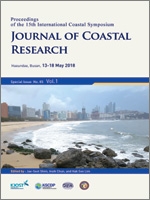Heo, K.-Y.; Choi, J.-Y.; Park, K.-S.; Kwon, J.-I.; Min, I.-K., and Ha, T., 2018. Explosively developing extratropical cyclone associated with the high wind-waves along the east coast of Korea. In: Shim, J.-S.; Chun, I., and Lim, H.S. (eds.), Proceedings from the International Coastal Symposium (ICS) 2018 (Busan, Republic of Korea). Journal of Coastal Research, Special Issue No. 85, pp. 716–720. Coconut Creek (Florida), ISSN 0749-0208.
An extreme extratropical cyclone struck the northern part of Korea on May 3, 2016 causing significant damage to property on the land due to extreme winds and abnormal high waves in coastal area. The meteorological composite fields for the cyclone show a strong surface wind velocity (up to 45 m s−1) during its mature stage. This study investigated the development mechanisms of an explosive cyclone through numerical simulation and sensitivity experiments using the Advanced Research version of the Weather Research and Forecasting (WRF-ARW) model. The trigger mechanism for the explosive cyclogenesis is the strong baroclinic instability and temperature advection associated with upper-level cut-off low and the interaction of potential vorticity (PV) anomalies between the lower- and upper-level. The efficient placement of the high- and low-level jets forms a favorable environment for its development and transportation of water vapor and the instability energy into the cyclone. The sea-state wave simulation around the Korean Peninsula is obtained using the wave model WAVEWATCHIII (WW3) forced by the 10-m above ground level wind field from the WRF-ARW simulations. The significant wave height and peak wave direction were simulated and wave distribution was analyzed by comparing the removal of the upper-level PV with the doubled. The numerical results using the doubled upper-level PV reproduced well generation of high waves around the Korean Peninsula while not the removal of the upper-level PV.





